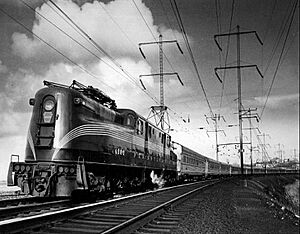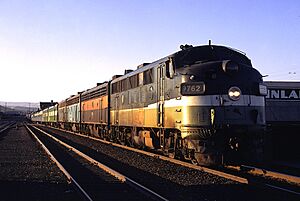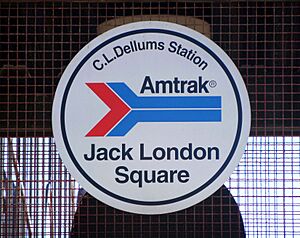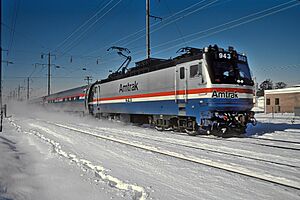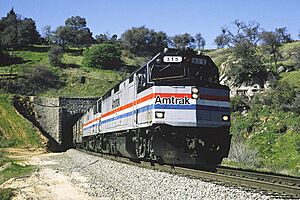Amtrak facts for kids
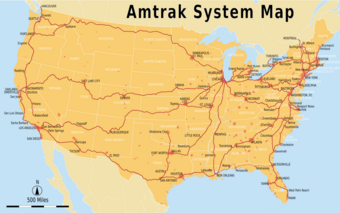
Amtrak system as of July 2025
|
|
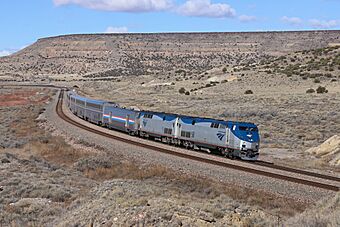
The Southwest Chief, one of Amtrak's long-distance trains in the Western United States, in Laguna, New Mexico
|
|
| Overview | |
|---|---|
| Headquarters | 1 Massachusetts Ave. NW Washington, D.C., U.S. |
| Reporting mark | AMTK and AMTZ IATA code: 2V |
| Locale |
|
| Dates of operation | May 1, 1971–present |
| Predecessors | 20 privately operated intercity passenger rail systems |
| Technical | |
| Track gauge | 4 ft 8 1⁄2 in (1,435 mm) standard gauge |
| Electrification |
|
| Length |
|
The National Railroad Passenger Corporation, known as Amtrak, is the main passenger train company in the United States. Its name, "Amtrak," is a mix of the words America and track.
Amtrak runs trains in almost all parts of the United States, except for Wyoming and South Dakota. It also serves three provinces in Canada. Amtrak started in 1971 to take over many passenger train routes. It gets money from both state and federal governments, but it tries to run like a business. Its main office is in Washington, D.C.
Amtrak's network has over 500 stations and covers about 21,400 miles of track. Amtrak owns about 623 miles of this track. The rest of the tracks belong to other railroad companies. Most trains travel at 79 miles per hour or less. However, some lines allow speeds up to 110 miles per hour. Parts of the Northeast Corridor can even handle speeds up to 160 miles per hour.
In 2024, Amtrak served 32.4 million passengers and earned $2.5 billion. It had more than 22,100 employees. About 87,000 people ride Amtrak trains every day. Most passengers travel on shorter routes, less than 400 miles long.
Contents
History of Amtrak
Early Passenger Train Service
A long time ago, in 1916, almost all people traveling between cities in the United States used trains. Private companies owned and operated these passenger trains, along with freight trains. However, as time went on, fewer people rode trains. More people started using buses, airplanes, and cars. Even new, faster trains couldn't stop this change. By 1940, train travel had dropped a lot.
During World War II, train travel became very popular again because soldiers needed to move around, and gasoline was limited for cars. After the war, railroads tried to make their trains better with new, fancy ones. But this only helped for a little while. By the 1950s, trains were losing a lot of money on passenger service. This made it hard for many railroad companies to stay in business.
Many reasons caused this decline. The government built new highways and airports, which competed directly with trains. Also, more Americans started buying cars after the war. Old rules for railroad workers and unions also made it hard for train companies to make a profit. For example, workers were paid a full day's wage for traveling only 100 to 150 miles, which modern trains could cover very quickly.
By the 1960s, the situation was critical. Many train routes were stopped. When the U.S. Post Office started sending mail by trucks and planes instead of trains, passenger trains lost a lot of money. The trains themselves were also getting old and needed to be replaced.
How Amtrak Was Formed
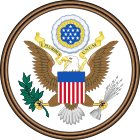 |
|
| Long title | An act to provide financial assistance for and establishment of a national rail passenger system, to provide for the modernization of railroad passenger equipment, to authorize the prescribing of minimum standards for railroad passenger service, to amend section 13a of the Interstate Commerce Act, and for other purposes. |
|---|---|
| Enacted by | the 91st United States Congress |
| Citations | |
| Public law | Pub.L. 91-518 |
| Statutes at Large | 84 Stat. 1327 |
| Codification | |
| Acts amended | Interstate Commerce Act |
| Legislative history | |
|
|
To save passenger train service, different ideas were suggested. In October 1970, the U.S. Congress passed a law called the Rail Passenger Service Act. President Richard Nixon signed it, even though some of his advisors disagreed. This law created the National Railroad Passenger Corporation (NRPC), which became known as Amtrak.
Amtrak was set up as a special kind of company. It was meant to be managed like a business that makes money, but it would also get money from taxpayers. Its main job was to take over running passenger trains between cities. Many people involved in creating the law didn't think Amtrak would actually make a profit, but this idea helped get support for the bill.
Here are some important parts of the law:
- Any railroad company that ran passenger trains could join the new national system by making a deal with Amtrak.
- The U.S. government would own special shares in Amtrak.
- Railroads that joined Amtrak would pay money or give trains and equipment to Amtrak. In return, they would get common shares in Amtrak.
- After May 1, 1971, railroads that joined Amtrak no longer had to run passenger trains, except for certain routes chosen by the government and paid for by Amtrak.
- Railroads that chose not to join Amtrak had to keep running their passenger service until 1975.
Out of 26 railroad companies offering passenger service in 1970, only six chose not to join Amtrak.
Many people thought Amtrak would not last long. The government hoped it would be a temporary solution. But Amtrak became more popular than critics expected and continued to operate.
Choosing the First Routes
The Rail Passenger Service Act gave the Secretary of Transportation, John A. Volpe, 30 days to decide which routes Amtrak would serve. On November 24, Volpe suggested 27 routes. However, President Nixon and his advisors thought this was too many and wanted to cut the number of routes in half.
The public and Congress were not happy with the smaller list of 16 routes. After more discussions, the final list of 21 routes was decided on January 28, 1971. Amtrak then had only three months to choose the exact paths these trains would take.
Around the same time, Amtrak hired a company to create a brand name and logo. On March 30, they chose the "headless arrow" logo and the name "Amtrak," which combined "America" and "track." This new name was announced just before trains started running.
The "Rainbow Era" (1970s)
Amtrak started running trains on May 1, 1971. At first, Amtrak did not own any train tracks. All of its routes were ones that private companies had run before. Amtrak kept about half of the old passenger train network. For example, the Coast Starlight train, which combined three old routes, was very popular right away.
Amtrak leased about 1,200 passenger cars from the private railroads. These cars were air-conditioned and mostly made of stainless steel. When Amtrak began, the trains had cars and engines painted in the colors of their old owners. This made trains look like a "rainbow" of different colors. By 1975, most Amtrak trains were painted in Amtrak's own colors.
Amtrak also had problems with train stations. Many were old and needed repairs. In Chicago, for example, trains used to use five different stations. Amtrak tried to simplify this by moving trains to fewer stations. In New York City, Amtrak had to use two stations until a new track connection was built in 1991.
In 1976, Amtrak bought most of the Northeast Corridor (NEC) tracks. This main line, between Washington, D.C., and Boston, became very important for Amtrak. Even though the NEC brought in a lot of money, it was very expensive to operate and maintain. This meant Amtrak needed more money from the government. Over time, Amtrak also gained ownership of other short sections of track.
In its first ten years, Amtrak did not become financially independent, which is still true today. But it did succeed in bringing back some train travel. Things like fuel shortages, which made car and plane travel more expensive, helped Amtrak. Amtrak's ridership grew from 16.6 million in 1972 to 21 million in 1981.
Building and Growing (1980s and 1990s)
In 1982, W. Graham Claytor, Jr., a former head of the Southern Railway, became Amtrak's leader. He helped improve the high-speed Metroliner Service between Washington and New York. Travel time between these cities was cut to under 3 hours. This helped Amtrak gain more passengers on this route.
Amtrak added two new trains in 1983: the California Zephyr and the Auto Train. The Auto Train is special because it carries both passengers and their cars. It runs between Virginia and Florida, helping people avoid driving on a busy highway.
During the 1980s and 1990s, major train stations in Baltimore, Chicago, and Washington, D.C., were renovated. In 1991, the Empire Connection tunnel opened in New York City. This allowed all Amtrak trains in New York to use Penn Station. Despite these improvements, the number of Amtrak passengers stayed around 20 million per year.
In the early 1990s, Amtrak tested fast trains from Europe on the Northeast Corridor. In 1999, Amtrak announced its plan for the Acela Express, a high-speed train for the Northeast Corridor. Changes were made to the tracks to allow these faster electric trains to run.
Growth in the 21st Century
The number of Amtrak passengers increased in the early 2000s. This was partly due to improvements on the Northeast Corridor and higher gasoline prices. The new Acela high-speed train, launched in late 2000, also brought a lot of attention and more riders.
By 2002, it was clear that Amtrak could not become fully self-sufficient (meaning it couldn't cover all its costs from ticket sales). However, Congress continued to provide funding. David L. Gunn, who became president in 2002, argued that no form of passenger transportation in the U.S. is completely self-sufficient, as highways and airports also receive government money. He focused on fixing old equipment and reducing deferred maintenance.
In 2007, Amtrak had 20,000 employees and served 25 million passengers a year, its highest number since it started. A key challenge for Amtrak has always been that it often loses money. Congress usually provides enough money to keep Amtrak running, but not always enough to fix all its problems.
In 2011, Amtrak announced plans for the Gateway Program. This project aims to improve and expand the high-speed rail corridor under the Hudson River in New York, including building new tunnels.
From 2011 to 2012, Amtrak celebrated its 40th anniversary. They published a book, made a documentary, painted six locomotives in old Amtrak colors, and had an Exhibit Train tour the country.
In 2021, during the COVID-19 pandemic, Amtrak continued to operate as an essential service. It required face coverings and limited ticket sales. Many long-distance routes were temporarily reduced to fewer trips per week.
In March 2021, Amtrak announced a plan called Amtrak Connects US. This plan aims to expand train service to new cities across the country, including places like Las Vegas, Phoenix, and Nashville. Most long-distance routes returned to daily service in late May 2021.
How Amtrak Operates
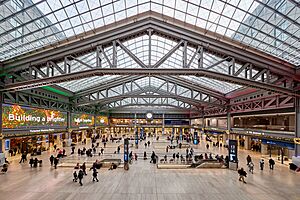
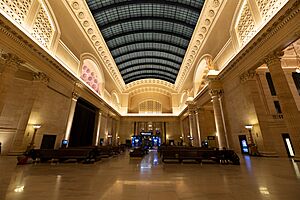
Train Routes
Amtrak is required by law to operate a national train system. It serves 46 of the 48 states in the mainland U.S., plus Washington, D.C. (Wyoming and South Dakota only have connecting bus services). Amtrak's services are divided into three main types:
- Northeast Corridor (NEC) services: These are trains like the Acela and Northeast Regional that run between Boston and Washington, D.C. These trains use electricity from overhead lines.
- State-supported services: These are shorter routes (less than 750 miles) outside the NEC. States help pay for these services.
- Long-distance services: These routes are longer than 750 miles and receive money from the federal government. Most of these trains use diesel-electric engines.
Amtrak also runs commuter trains for other agencies in Maryland, Connecticut, and Southern California.
Train frequency varies a lot. Some trains, like the Sunset Limited, run only three days a week. Others on the Northeast Corridor run several times an hour. For places not served by trains, Amtrak Thruway buses and other transport options connect to train stations.
The most popular services are on the Northeast Corridor. In 2021, these services carried 4.4 million passengers. Outside the NEC, popular services are in California, like the Pacific Surfliner.
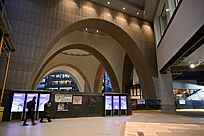
The busiest Amtrak stations are:
- New York Penn Station
- Washington Union Station
- Philadelphia 30th Street Station
- Chicago Union Station
- Boston South Station
- Los Angeles Union Station
On-Time Performance
Amtrak measures if a train is on time differently from airlines. For trains, being on time means arriving within a certain number of minutes of the schedule, depending on how long the trip is. For example, a trip under 250 miles is late if it's more than 10 minutes behind schedule.
Most Amtrak trains outside the Northeast Corridor run on tracks owned by private freight railroad companies. Federal law says that freight railroads must give Amtrak passenger trains priority. However, Amtrak has sometimes said that freight railroads don't follow these rules, causing passenger trains to wait.
In 2008, new laws were made to ensure trains were given priority. After this, Amtrak's on-time performance improved a lot. For example, the Missouri River Runner went from being on time only 11% of the time to 95%. This improvement also happened when there was less freight train traffic.
Amtrak now gives "report cards" to the freight railroads that host its trains. These cards grade how well the freight railroads help Amtrak trains stay on schedule. In 2023, Canadian Pacific Kansas City got an A, while Union Pacific got a C-.
Between 2018 and 2023, Amtrak's trains were on time about 74.5% of the time. The Northeast Corridor had the best on-time performance at 81.3%. Most delays were caused by the host freight railroads.
Number of Passengers
Amtrak carried 15.8 million passengers in 1972, its first full year. The number of passengers has generally increased since then. In 2019, Amtrak carried a record 32 million passengers. Due to the COVID-19 pandemic, ridership dropped to 16.8 million in 2020 and 12.2 million in 2021. However, it started to recover, reaching 28.6 million in 2023 and a new record of 32.8 million in 2024.
Guest Rewards Program
Amtrak has a loyalty program called Guest Rewards. It's like airline frequent-flyer programs. Members earn points by riding trains or doing other activities. They can then use these points to get free Amtrak tickets or other rewards.
Rail Passes
Amtrak offers special passes for travelers. The USA rail pass lets you take 10 train rides in 30 days. The California rail pass allows 7 days of travel within a 21-day period.
Tracks and Facilities Owned by Amtrak
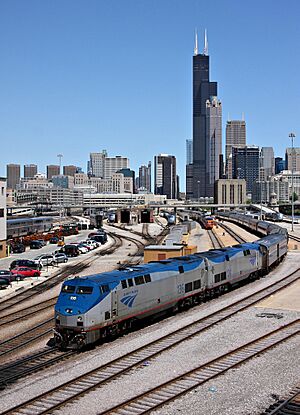
Amtrak owns about 730 miles of track, mostly on the Northeast Corridor. This includes tunnels and bridges. In some areas, Amtrak leases tracks from state or local governments.
Amtrak owns and operates these main lines:
- Northeast Corridor: Most of the track between Washington, D.C., and Boston.
- Keystone Corridor: The 104.2-mile line from Philadelphia to Harrisburg, Pennsylvania. This line allows electric trains to go up to 110 miles per hour.
- Empire Corridor: An 11-mile section near New York City. Amtrak also leases a longer section from CSX.
- Michigan Line: A 98-mile section between Porter, Indiana, and Kalamazoo, Michigan.
- New Haven–Springfield Line: A 62-mile section between New Haven, Connecticut, and Springfield, Massachusetts.
- Post Road Branch: A 12.42-mile section in New York.
Amtrak also owns train stations and yards in many major cities like Chicago, Los Angeles, New York City, and Washington, D.C. It owns important stations like New York Penn Station and Chicago Union Station.
Service Lines
Amtrak organizes its work into six "service lines," which are like different departments:
- Northeast Corridor: Manages high-speed Acela and Northeast Regional trains.
- State Supported: Runs shorter routes (under 750 miles) with states helping to pay.
- Long Distance: Operates routes over 750 miles, with federal government support.
- Real Estate & Commercial: Manages Amtrak's properties.
- Infrastructure Access/Reimbursable: Charges other railroads for using Amtrak's tracks and does maintenance work that other railroads pay for.
- Ancillary: Provides other services, like running commuter trains for other agencies, connecting bus services, and charter trains.
On-Board Services
Classes of Service
Amtrak offers four types of service: First Class, First Class Sleeper Service, Business Class, and Coach Class.
- First Class: Only available on the Acela train. Seats are larger, and a car attendant serves a free meal and drinks. Passengers can also use special lounges at bigger stations.
- First Class Sleeper Service: Private rooms on long-distance trains. These include small rooms called roomettes and larger bedrooms. The price includes attendant service and hot meals on most routes. At night, the rooms are made into sleeping areas with beds. Showers are available. Passengers can also use lounges at some stations.
- Business Class: Offered on Acela, Northeast Regional, and some other trains. Seats often have more legroom and free non-alcoholic drinks. Seats recline and have tray tables, footrests, reading lights, and power outlets.
- Coach Class: The standard service on most Amtrak trains. Seats recline and have tray tables, footrests, reading lights, and power outlets. On long-distance trains, coach cars have fewer seats for more legroom and leg rests. Some trains have a "quiet car" where passengers are asked to be quiet and not make phone calls.
Wi-Fi and Electronic Services
Amtrak started offering free Wi-Fi on some trains in 2008 and expanded it to most trains by 2014. Most Amtrak passengers now have access to free Wi-Fi. However, the service can sometimes be unreliable or slow, especially on routes that go through areas with poor cell service. Wi-Fi is generally better on routes east of the Mississippi River.
Amtrak also launched an e-ticketing system in 2012. This system allows Amtrak to know who is on the train in real-time, which helps with safety and security.
Baggage and Cargo Services

Amtrak allows passengers to bring carry-on bags on all routes. Some stations also allow checked baggage, which travels in special baggage cars.
Amtrak is popular with people who like to travel with their bicycles. Unlike airlines, most Amtrak trains have bike racks, so you don't have to take your bike apart. You usually need to reserve a spot for your bike, and it costs a small fee.
Environmental Impact
Trains are generally more energy-efficient than airplanes and cars. Amtrak trains are 30–40 percent more energy-efficient per passenger mile. Most of Amtrak's trains use diesel fuel. However, electric trains, used on the Northeast Corridor, are even more efficient and produce less carbon dioxide. They can also send energy back to the power grid when they brake.
In 2005, Amtrak's carbon dioxide emissions per passenger were about the same as a car with two people. This is less than a long-distance domestic flight.
Funding for Amtrak
Amtrak receives money each year from the federal and state governments to help with its operations and improvements.
Funding History
Amtrak started in 1971 with some money from the government and loans. Officials hoped Amtrak would make enough money to cover its costs by 1974, but this did not happen. Government aid increased over the years. In the 1980s and 1990s, government funding was reduced. Amtrak had to borrow money, and by 1995, it was in financial trouble. In 1997, Congress gave Amtrak $5.2 billion over five years, mainly to help with the Acela project. This money came with the condition that Amtrak had to become financially self-sufficient by 2003 or face being shut down. Amtrak improved financially but did not become fully self-sufficient.
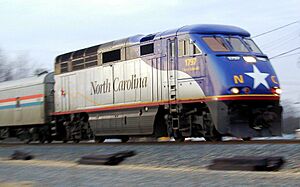
In the 2000s, a disagreement over federal funding led to service cuts and delayed maintenance. In 2006, Amtrak received almost $1.4 billion. This came with the condition that Amtrak would reduce losses from food and sleeper services. As a result, dining car service was simplified.
State governments have also helped Amtrak. Several states, including California, Pennsylvania, and Illinois, work with Amtrak to operate routes. The Canadian province of British Columbia also helps with the Cascades route.
When gasoline prices went up a lot in 2007–08, more people rode Amtrak trains. In 2008, a new law was passed that gave Amtrak $2.6 billion a year through 2013.
In 2010, Amtrak reported that it covered 79% of its operating costs with money from ticket sales. This increased to 94.9% in 2018. Amtrak has said it needs more money to replace old trains because maintaining them is more expensive than buying new ones.
In 2021, the U.S. Congress passed a law that gave Amtrak $66 billion for rail over five years. This money is meant to expand passenger rail service to new areas.
Controversies About Funding
Government money for Amtrak has always been a topic of discussion. Some people believe that Amtrak should not receive public money and that train service should be run by private companies. They argue that Amtrak doesn't operate like a profitable business. Other people disagree, saying that public transportation like trains, highways, and airports all need government support.
The law that created Amtrak in 1970 stated that Amtrak is not a government agency. Private railroad companies received shares in Amtrak when it was formed. The U.S. government also holds many special shares in Amtrak.
Leadership
Amtrak's Board of Directors includes the United States Secretary of Transportation and Amtrak's CEO. There are also eight other members chosen by the President and approved by the Senate. These members serve for five years. No more than five of the eight members can be from the same political party. At least two, but no more than four, must live near the Northeast Corridor. The others must live in states served by Amtrak's long-distance or state-supported routes. At least one member must be a person with a disability.
Current Board Members
The current board members as of August 2025 are:
| Position | Name | State of residence | Party | Confirmed | Term expires |
|---|---|---|---|---|---|
| Secretary of Transportation |
Sean Duffy | New Jersey | Republican | January 28, 2025 | No fixed term |
| CEO (non-voting) |
Vacant | No fixed term | |||
| Chair | Anthony Coscia | New Jersey | Democratic | June 22, 2010 December 15, 2015 January 23, 2024 |
January 2029 |
| Vice Chair | Joel Szabat | Maryland | Republican | January 23, 2024 | January 2029 |
| Member | Lanhee Chen | California | Republican | December 21, 2024 | December 2029 |
| Member | Elaine Marie Clegg | Idaho | Democratic | December 21, 2024 | December 2029 |
| Member | Christopher Koos | Illinois | Democratic | January 23, 2024 | January 2029 |
| Member | David Michael Capozzi | Maryland | Democratic | December 21, 2024 | December 2029 |
| Member | Ronald L. Batory | New Mexico | Republican | December 21, 2024 | December 2029 |
| Member | Vacant |
Images for kids
See also
 In Spanish: Amtrak para niños
In Spanish: Amtrak para niños


